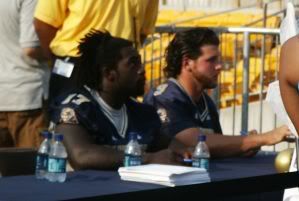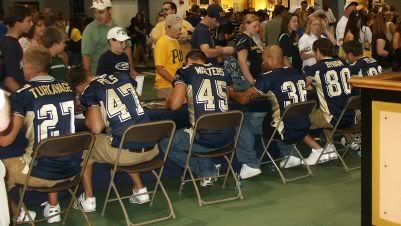The Citadel is getting $350,000 to come to Pittsburgh for the D1-AA patsy game that is now an annual event for Pitt.
“Why are we playing 12 games? Let’s not kid ourselves,” West Virginia coach Rich Rodriguez said. “It’s not for the excitement of college football. It’s to make more money.”
For West Virginia and Pitt, one home game generates between $1.5 million and $2 million for the athletic department.
With eight members, the Big East is the smallest of the BCS leagues. Some years, Pitt has just three Big East home games. That means Long must set up five nonconference games every season — and at least three of them had better be at Heinz Field, to maximize the cash flow.
But to make money, Long must spend money.
“The bidding is more intense now,” Long said. “Price-gouging is out there. I would say that $300,000 is not exorbitant. In fact, for a lot of those I-AA schools, that’s the low end. Some schools with huge stadiums are really driving the market upward. For those with 50,000- and 60,000-seat stadiums, like ourselves, it’s hard to compete just because we can’t generate the same revenue.”
This isn’t anything new, but that is definitely sour grapes from AD Jeff Long. It’s not price gouging. It’s the marketplace.
Add a 12th game to make more money, the demand for the money-maker (i.e., easy home game, without a return trip) among BCS schools goes up. Ergo the price for such opponents go up. If schools are willing to pay the asking price, and they still make money then they aren’t paying an “unfair” price. What Long is complaining about is that the amount of money the Pitt Athletic Department is making from the game isn’t as high as it used to be when there wasn’t as much demand for the games and the prices were lower.
I doubt he’d accept claims from Pitt season ticket holders that they are being price gouged for having to pay the same face value price for a game against the Citadel as they do for the Backyard Brawl.
This season, Troy State will get $750,000 to play at Nebraska. Buffalo broke its contract to play West Virginia to accept a bigger payday from Auburn. To fill the open date, WVU gave a $450,000 deal to Eastern Washington.
Last year, Youngstown State got $250,000 to play Pitt at Heinz Field. YSU squeezed every dollar it could out of the game, busing to and from Pittsburgh on the day of the game to hold the line on travel expenses.
Next month, Youngstown State will face Penn State, its first Big Ten opponent. Curley lined up YSU — the Lions’ first I-AA foe since 1984 — after Louisiana Tech backed out of its contract with Penn State due to scheduling conflicts in the realigned Western Athletic Conference.
Youngstown State will receive $350,000 for the overnight trip to Happy Valley. YSU also announced it will open its 2007 and ’08 seasons against Ohio State in Columbus, and collect $650,000 for each game.
“The 12th game for Division I, obviously, has helped us,” Youngstown State athletic director Ron Strollo said. “We going to be smart about it. We’ve got to be able to make a dollar on it. It’s got to help our recruiting. And we try to keep it close, so our fans can get there.”
In a twist, Youngstown State, a I-AA program, also pays a smaller, local school for a game. In 11 days, the Penguins will open their season against Division II Slippery Rock.
Interesting in the story how Penn State won’t be taking advantage of the scheduling relationship with the MAC that the Big 11 has established because the MAC is insisting on getting a home game out of any arrangement. Good for them.
Then there’s this almost wonkish piece on the digitial video taping of practice and breaking down film for the players.
Palko is a game-film addict who runs down a checklist of things he reviews on film, from his footwork on five-step drops to whether he opens his stance at a 45-degree angle on throws or if his shoulders and hips are aligned to his intended target and if his eyes can fool a safety.
Pitt’s DVSport digital equipment allows video coordinator Chad Bogard to load the video onto its computer system and send it to coaches’ laptops the moment practice ends. The coaches break down the video and make their assessments before each position and team meeting.
“Whatever you see on the field happens in a split-second sometimes,” Pitt offensive coordinator Matt Cavanaugh said. “As coaches, we’re quick to always have an answer. I may scream at somebody for doing something wrong and I look at the tape and they did it right or vice versa.
“It’s made us a lot more efficient. We’re able now as coaches to go in and, within five minutes, take a 100-play game and make cutups so we know what we want. In the old days, we literally had to splice the film, where you had canister after canister after canister of cutups.”
The All-22 shots are especially helpful to the offensive and defensive linemen, who can see how they handled their assignments and whether they are working cohesively. They can zoom in on body parts to study their foot work or hand placement, essential parts of their technique.
It’s almost buried behind the fascination of the cameras being up on 60-feet and 40-feet cranes. The stuff that can be done with digital video is just tremendous. I know I only scratch the surface when I play with it at home. The stuff Pitt is using, from the cameras to the software is so advanced.






